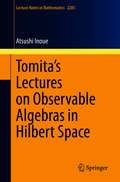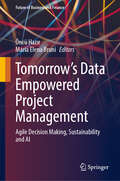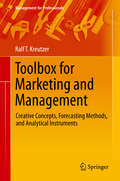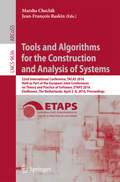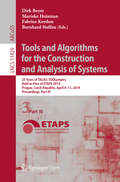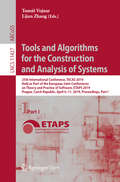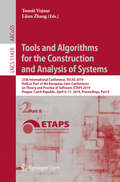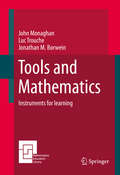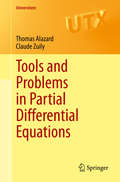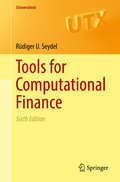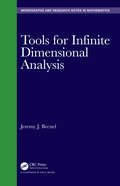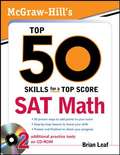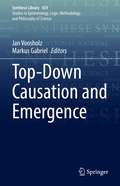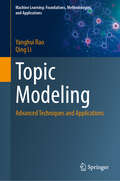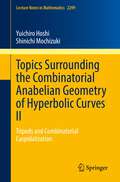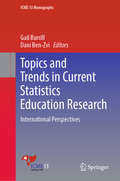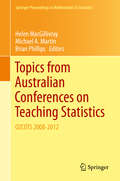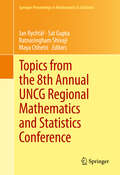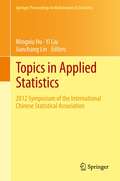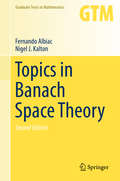- Table View
- List View
Tomita's Lectures on Observable Algebras in Hilbert Space (Lecture Notes in Mathematics #2285)
by Atsushi InoueThis book is devoted to the study of Tomita's observable algebras, their structure and applications.It begins by building the foundations of the theory of T*-algebras and CT*-algebras, presenting the major results and investigating the relationship between the operator and vector representations of a CT*-algebra. It is then shown via the representation theory of locally convex*-algebras that this theory includes Tomita–Takesaki theory as a special case; every observable algebra can be regarded as an operator algebra on a Pontryagin space with codimension 1. All of the results are proved in detail and the basic theory of operator algebras on Hilbert space is summarized in an appendix.The theory of CT*-algebras has connections with many other branches of functional analysis and with quantum mechanics. The aim of this book is to make Tomita’s theory available to a wider audience, with the hope that it will be used by operator algebraists and researchers in these related fields.
Tommys Ziemlich Spaßiger Tag
by Linda HendersonEin Jahrmarkt verspricht interessante Erfahrungen für Junge und im Herzen Jung gebliebene. Tommy liebt vor allem die Fahrgeschäfte und die Tiere auf dem Jahrmarkt. Er mag es auch zahlen in seinem Kopf zu addieren. Dabei erfährt er, dass es auf dem Jahrmarkt vieles zu addieren gibt. Er hörte zu, wie sein Onkel Al die Kosten der Tickets addierte, als sein Onkel die Lebenslektion mit ihm teilte, dass es wichtig ist jeden gerecht und gleich zu behandeln. Wir können alle etwas davon lernen, was Onkel Al Tommy erzählt hat. In diesem einfach zu lesenden Buch für 6 bis 8-jährige, können Kinder Spaß mit Tommy und seiner Familie haben, während sie über den Jahrmarkt laufen. Sie können ihr Gehirn mit etwas Mathematik trainieren. Und am Ende des Buches, werden Kinder an den größten Gleichmacher von allen herangeführt.
Tomorrow's Data Empowered Project Management: Agile Decision Making, Sustainability and AI (Future of Business and Finance)
by Öncü Hazır Maria Elena BruniProject management (PM) has been an essential area that deals with various decision-making problems. It offers various opportunities to conduct academic studies, formulate new models to solve business problems, and develop software and decision support systems (DSS). It has been attracting the attention of academicians and professionals involved in project teams who studied different disciplines. This book explores contemporary industry problems and trends and related promising research areas, shedding light on the future of project management. It contains chapters that focus on new technology applications and organizational trends. The book comprises two parts: new technologies and recent developments in organizing projects. An important characteristic of this book is to gather the managers and academics who conduct theoretical studies in this field to discuss the future of project management. The discussion topics include how data analytics and artificial intelligence developments might shape project life cycle management and how the Fourth/Fifth Industrial Revolution and the new technologies will transform project management practices. The importance of sustainability in project management practices is elaborated on. Recent developments in the organization of projects, such as adopting agile techniques, establishing project management offices, and developing maturity models, are discussed. As such, the book is aimed at a diverse audience of undergraduate and graduate students and practitioners seeking to develop their project management knowledge.
Too-Small Tyson (Storytelling Math)
by JaNay Brown-WoodCelebrate diversity, math, and the power of storytelling!Tyson is the youngest-smaller than his four older brothers and always trying to keep up. But when the family's pet gerbil, Swish, goes missing, it's Tyson to the rescue! Tyson uses his knowledge of doubles, triples, and sizes to figure out a clever way to reach his beloved pet. A playful exploration of proportional thinking, featuring an author letter about the ubiquitous nature of math. Storytelling Math celebrates children using math in their daily adventures as they play, build, and discover the world around them. Joyful stories and hands-on activities make it easy for kids and their grown-ups to explore everyday math together. Developed in collaboration with math experts at STEM education non-profit TERC, under a grant from the Heising-Simons Foundation.
Toolbox for Marketing and Management: Creative Concepts, Forecasting Methods, and Analytical Instruments (Management for Professionals)
by Ralf T. KreutzerModern marketing managers need intuitive and effective tools not just for designing strategies but also for general management. This hands-on book introduces a range of contemporary management and marketing tools and concepts with a focus on forecasting, creating stimulating processes, and implementation. Topics addressed range from creating a clear vision, setting goals, and developing strategies, to implementing strategic analysis tools, consumer value models, budgeting, strategic and operational marketing plans. Special attention is paid to change management and digital transformation in the marketing landscape. Given its approach and content, the book offers a valuable asset for all professionals and advanced MBA students looking for ‘real-life’ tools and applications.
Tools and Algorithms for the Construction and Analysis of Systems
by Marsha Chechik Jean-François RaskinThis bookconstitutes the proceedings of the 22nd International Conference on Tools andAlgorithms for the Construction and Analysis of Systems, TACAS 2016, which tookplace in Eindhoven, The Netherlands, in April 2016, held as Part of theEuropean Joint Conferences on Theory and Practice of Software, ETAPS 2016. The 44 full papers presented in this volume were carefully reviewed and selectedfrom 175 submissions. They were organized in topical sections named: abstractionand verification; probabilistic and stochastic systems; synthesis; tool papers;concurrency; tool demos; languages and automata; security; optimization; andcompetition on software verification - SV-COMP.
Tools and Algorithms for the Construction and Analysis of Systems: 25 Years of TACAS: TOOLympics, Held as Part of ETAPS 2019, Prague, Czech Republic, April 6–11, 2019, Proceedings, Part III (Lecture Notes in Computer Science #11429)
by Fabrice Kordon Marieke Huisman Bernhard Steffen Dirk BeyerThis book is Open Access under a CC BY licence. This book, LNCS 11429, is part III of the proceedings of the 25th International Conference on Tools and Algorithms for the Construction and Analysis of Systems, TACAS 2019, which took place in Prague, Czech Republic, in April 2019, held as part of the European Joint Conferences on Theory and Practice of Software, ETAPS 2019. It's a special volume on the occasion of the 25 year anniversary of TACAS.
Tools and Algorithms for the Construction and Analysis of Systems: 25 Years of TACAS: TOOLympics, Held as Part of ETAPS 2019, Prague, Czech Republic, April 6–11, 2019, Proceedings, Part III (Lecture Notes in Computer Science #11429)
by Fabrice Kordon Marieke Huisman Bernhard Steffen Dirk BeyerThis book is Open Access under a CC BY licence. This book, LNCS 11429, is part III of the proceedings of the 25th International Conference on Tools and Algorithms for the Construction and Analysis of Systems, TACAS 2019, which took place in Prague, Czech Republic, in April 2019, held as part of the European Joint Conferences on Theory and Practice of Software, ETAPS 2019. It's a special volume on the occasion of the 25 year anniversary of TACAS.
Tools and Algorithms for the Construction and Analysis of Systems: 25th International Conference, TACAS 2019, Held as Part of the European Joint Conferences on Theory and Practice of Software, ETAPS 2019, Prague, Czech Republic, April 6–11, 2019, Proceedings, Part I (Lecture Notes in Computer Science #11427)
by Tomáš Vojnar Lijun ZhangThis book is Open Access under a CC BY licence. The LNCS 11427 and 11428 proceedings set constitutes the proceedings of the 25th International Conference on Tools and Algorithms for the Construction and Analysis of Systems, TACAS 2019, which took place in Prague, Czech Republic, in April 2019, held as part of the European Joint Conferences on Theory and Practice of Software, ETAPS 2019. The total of 42 full and 8 short tool demo papers presented in these volumes was carefully reviewed and selected from 164 submissions. The papers are organized in topical sections as follows: Part I: SAT and SMT, SAT solving and theorem proving; verification and analysis; model checking; tool demo; and machine learning. Part II: concurrent and distributed systems; monitoring and runtime verification; hybrid and stochastic systems; synthesis; symbolic verification; and safety and fault-tolerant systems.
Tools and Algorithms for the Construction and Analysis of Systems: 25th International Conference, TACAS 2019, Held as Part of the European Joint Conferences on Theory and Practice of Software, ETAPS 2019, Prague, Czech Republic, April 6–11, 2019, Proceedings, Part II (Lecture Notes in Computer Science #11428)
by Tomáš Vojnar Lijun ZhangThis book is Open Access under a CC BY licence. The LNCS 11427 and 11428 proceedings set constitutes the proceedings of the 25th International Conference on Tools and Algorithms for the Construction and Analysis of Systems, TACAS 2019, which took place in Prague, Czech Republic, in April 2019, held as part of the European Joint Conferences on Theory and Practice of Software, ETAPS 2019. The total of 42 full and 8 short tool demo papers presented in these volumes was carefully reviewed and selected from 164 submissions. The papers are organized in topical sections as follows: Part I: SAT and SMT, SAT solving and theorem proving; verification and analysis; model checking; tool demo; and machine learning. Part II: concurrent and distributed systems; monitoring and runtime verification; hybrid and stochastic systems; synthesis; symbolic verification; and safety and fault-tolerant systems.
Tools and Mathematics
by Jonathan M. Borwein Luc Trouche John MonaghanThis book is an exploration of tools and mathematics and issues in mathematics education related to tool use. The book has five parts. The first part reflects on doing a mathematical task with different tools, followed by a mathematician's account of tool use in his work. The second considers prehistory and history: tools in the development from ape to human; tools and mathematics in the ancient world; tools for calculating; and tools in mathematics instruction. The third part opens with a broad review of technology and intellectual trends, circa 1970, and continues with three case studies of approaches in mathematics education and the place of tools in these approaches. The fourth part considers issues related to mathematics instructions: curriculum, assessment and policy; the calculator debate; mathematics in the real world; and teachers' use of technology. The final part looks to the future: task and tool design and new forms of activity via connectivity and computer games.
Tools and Problems in Partial Differential Equations (Universitext)
by Thomas Alazard Claude ZuilyThis textbook offers a unique learning-by-doing introduction to the modern theory of partial differential equations.Through 65 fully solved problems, the book offers readers a fast but in-depth introduction to the field, covering advanced topics in microlocal analysis, including pseudo- and para-differential calculus, and the key classical equations, such as the Laplace, Schrödinger or Navier-Stokes equations. Essentially self-contained, the book begins with problems on the necessary tools from functional analysis, distributions, and the theory of functional spaces, and in each chapter the problems are preceded by a summary of the relevant results of the theory.Informed by the authors' extensive research experience and years of teaching, this book is for graduate students and researchers who wish to gain real working knowledge of the subject.
Tools for Computational Finance
by Rüdiger U. SeydelComputational and numerical methods are used in a number of ways across the field of finance. It is the aim of this book to explain how such methods work in financial engineering. By concentrating on the field of option pricing, a core task of financial engineering and risk analysis, this book explores a wide range of computational tools in a coherent and focused manner and will be of use to anyone working in computational finance. Starting with an introductory chapter that presents the financial and stochastic background, the book goes on to detail computational methods using both stochastic and deterministic approaches.Now in its sixth edition, Tools for Computational Finance has been significantly revised and contains: Several new parts such as a section on extended applications of tree methods, including multidimensional trees, trinomial trees, and the handling of dividends;Additional material in the field of generating normal variates with acceptance-rejection methods, and on Monte Carlo methods;115 exercises, and more than 100 figures, many in color.Written from the perspective of an applied mathematician, all methods are introduced for immediate and straightforward application. A ‘learning by calculating’ approach is adopted throughout this book, enabling readers to explore several areas of the financial world.Interdisciplinary in nature, this book will appeal to advanced undergraduate and graduate students in mathematics, engineering, and other scientific disciplines as well as professionals in financial engineering.
Tools for Infinite Dimensional Analysis (Chapman & Hall/CRC Monographs and Research Notes in Mathematics)
by Jeremy J. BecnelOver the past six decades, several extremely important fields in mathematics have been developed. Among these are Itô calculus, Gaussian measures on Banach spaces, Malliavan calculus, and white noise distribution theory. These subjects have many applications, ranging from finance and economics to physics and biology. Unfortunately, the background information required to conduct research in these subjects presents a tremendous roadblock. The background material primarily stems from an abstract subject known as infinite dimensional topological vector spaces. While this information forms the backdrop for these subjects, the books and papers written about topological vector spaces were never truly written for researchers studying infinite dimensional analysis. Thus, the literature for topological vector spaces is dense and difficult to digest, much of it being written prior to the 1960s. Tools for Infinite Dimensional Analysis aims to address these problems by providing an introduction to the background material for infinite dimensional analysis that is friendly in style and accessible to graduate students and researchers studying the above-mentioned subjects. It will save current and future researchers countless hours and promote research in these areas by removing an obstacle in the path to beginning study in areas of infinite dimensional analysis. Features Focused approach to the subject matter Suitable for graduate students as well as researchers Detailed proofs of primary results
Top 50 Skills for a Top Score: SAT Math
by Brian LeafWe want to help you succeed on the math portion of the SAT* "What a surprise, what a relief! An SAT guide that actually meets you where you are, talks to you with wit and compassion, and clears away the panic of test taking. "-- Rebecca Pepper Sinkler, former Editor, The New York Times Book Review We've put all of our proven expertise into McGraw-Hill's Top 50 Skills for a Top Score. With this book, you'll master the essential skills identified by a prominent SAT instructor and add points to your score. You'll get focused instruction on these crucial skills, helpful exercises, pre- and posttests to check your weaknesses and progress, and two additional tests on the accompanying CD-ROM. With McGraw-Hill's Top Skills for a Top Score: SAT Math, we'll guide you step by step through your preparation and give you the tools you need to succeed. Inside you'll find: 50 essential skills with step-by-step sample exercises A pretest to identify your weaknesses and a posttest to track your progress Two additional tests on CD-ROM Strategies to help you answer every type of SAT math item
Top-Down Causation and Emergence (Synthese Library #439)
by Markus Gabriel Jan VoosholzThis book presents the latest research, conducted by leading philosophers and scientists from various fields, on the topic of top-down causation. The chapters combine to form a unique, interdisciplinary perspective, drawing upon George Ellis's extensive research and novel perspectives on topics including downwards causation, weak and strong emergence, mental causation, biological relativity, effective field theory and levels in nature. The collection also serves as a Festschrift in honour of George Ellis' 80th birthday. The extensive and interdisciplinary scope of this book makes it vital reading for anyone interested in the work of George Ellis and current research on the topics of causation and emergence.
Topic Modeling: Advanced Techniques and Applications (Machine Learning: Foundations, Methodologies, and Applications)
by Qing Li Yanghui RaoAs a well-known text mining tool, topic modeling can effectively discover the latent semantic structure of text data. Extracting topics from documents is also one of the fundamental challenges in natural language processing. Although topic models have seen significant achievements over the past three decades, there remains a scarcity of methods that effectively model temporal aspect. Moreover, many contemporary topic models continue to grapple with the issue of noise contamination, particularly in social media data. This book presents several approaches designed to address these two limitations. Initially, traditional lifelong topic models aim to accumulate knowledge learned from experience for future task. However, the sequence of topics extracted by these methods may shift over time, leading to semantic misalignment between the topic representations across document streams. Such misalignment can degrade the performances of various downstream tasks, including online document classification and dynamic information retrieval at the topic level. Additionally, the challenge of coherent topic modeling is particularly relevant due to the noise and large scale of social media datasets. Messages on social media platforms often consists of only a few words, resulting in a lack of significant context. Models applied directly to this type of text frequently encounter the problem of feature sparsity, which can yield unsatisfactory outcomes. In the context of emotion detection, public emotions are known to fluctuate across different topics, and topics can evoke public emotion. Thus, there is a strong interconnection between topic discovery and emotion detection. Jointly modeling topics and emotions is a suitable strategy for these tasks. This book also examines the impact of topics on emotion detection and other related areas.
Topics Surrounding the Combinatorial Anabelian Geometry of Hyperbolic Curves II: Tripods and Combinatorial Cuspidalization (Lecture Notes in Mathematics #2299)
by Yuichiro Hoshi Shinichi MochizukiThe present monograph further develops the study, via the techniques of combinatorial anabelian geometry, of the profinite fundamental groups of configuration spaces associated to hyperbolic curves over algebraically closed fields of characteristic zero.The starting point of the theory of the present monograph is a combinatorial anabelian result which allows one to reduce issues concerning the anabelian geometry of configuration spaces to issues concerning the anabelian geometry of hyperbolic curves, as well as to give purely group-theoretic characterizations of the cuspidal inertia subgroups of one-dimensional subquotients of the profinite fundamental group of a configuration space.We then turn to the study of tripod synchronization, i.e., of the phenomenon that an outer automorphism of the profinite fundamental group of a log configuration space associated to a stable log curve induces the same outer automorphism on certain subquotients of such a fundamental group determined by tripods [i.e., copies of the projective line minus three points]. The theory of tripod synchronization shows that such outer automorphisms exhibit somewhat different behavior from the behavior that occurs in the case of discrete fundamental groups and, moreover, may be applied to obtain various strong results concerning profinite Dehn multi-twists.In the final portion of the monograph, we develop a theory of localizability, on the dual graph of a stable log curve, for the condition that an outer automorphism of the profinite fundamental group of the stable log curve lift to an outer automorphism of the profinite fundamental group of a corresponding log configuration space. This localizability is combined with the theory of tripod synchronization to construct a purely combinatorial analogue of the natural outer surjection from the étale fundamental group of the moduli stack of hyperbolic curves over the field of rational numbers to the absolute Galois group of the field of rational numbers.
Topics and Trends in Current Statistics Education Research: International Perspectives (ICME-13 Monographs)
by Gail Burrill Dani Ben-ZviThis book focuses on international research in statistics education, providing a solid understanding of the challenges in learning statistics. It presents the teaching and learning of statistics in various contexts, including designed settings for young children, students in formal schooling, tertiary level students, and teacher professional development. The book describes research on what to teach and platforms for delivering content (curriculum), strategies on how to teach for deep understanding, and includes several chapters on developing conceptual understanding (pedagogy and technology), teacher knowledge and beliefs, and the challenges teachers and students face when they solve statistical problems (reasoning and thinking). This new research in the field offers critical insights for college instructors, classroom teachers, curriculum designers, researchers in mathematics and statistics education as well as policy makers and newcomers to the field of statistics education. Statistics has become one of the key areas of study in the modern world of information and big data. The dramatic increase in demand for learning statistics in all disciplines is accompanied by tremendous growth in research in statistics education. Increasingly, countries are teaching more quantitative reasoning and statistics at lower and lower grade levels within mathematics, science and across many content areas. Research has revealed the many challenges in helping learners develop statistical literacy, reasoning, and thinking, and new curricula and technology tools show promise in facilitating the achievement of these desired outcomes.
Topics from Australian Conferences on Teaching Statistics
by Michael A. Martin Helen Macgillivray Brian PhillipsThe first OZCOTS conference in 1998 was inspired by papers contributed by Australians to the 5th International Conference on Teaching Statistics. In 2008, as part of the program of one of the first National Senior Teaching Fellowships, the 6th OZCOTS was held in conjunction with the Australian Statistical Conference, with Fellowship keynotes and contributed papers, optional refereeing and proceedings. This venture was so successful that the 7th and 8th OZCOTS were similarly run, conjoined with Australian Statistical Conferences in 2010 and 2012. Authors of papers from these OZCOTS conferences were invited to develop chapters for refereeing and inclusion in this volume. There are sections on keynote topics, undergraduate curriculum and learning, professional development, postgraduate learning, and papers from OZCOTS 2012. Because OZCOTS aim to unite statisticians and statistics educators, the approaches this volume takes are immediately relevant to all who have a vested interest in good teaching practices. Globally, statistics as a discipline, statistical pedagogy and statistics in academia and industry are all critically important to the modern information society. This volume addresses these roles within the wider society as well as questions that are specific to the discipline itself. Other chapters share research on learning and teaching statistics in interdisciplinary work and student preparation for futures in academia, government and industry
Topics from the 8th Annual UNCG Regional Mathematics and Statistics Conference
by Jan Rychtář Sat Gupta Ratnasingham Shivaji Maya ChhetriThe Annual University of North Carolina Greensboro Regional Mathematics and Statistics Conference (UNCG RMSC) has provided a venue for student researchers to share their work since 2005. The 8th Conference took place on November 3, 2012. The UNCG-RMSC conference established a tradition of attracting active researchers and their faculty mentors from NC and surrounding states. The conference is specifically tailored for students to present the results of their research and to allow participants to interact with and learn from each other. This type of engagement is truly unique. The broad scope of UNCG-RMSC includes topics in applied mathematics, number theory, biology, statistics, biostatistics and computer sciences.
Topics in Algebraic Graph Theory
by Lowell W. Beineke Robin J. WilsonThe rapidly expanding area of algebraic graph theory uses two different branches of algebra to explore various aspects of graph theory: linear algebra (for spectral theory) and group theory (for studying graph symmetry). These areas have links with other areas of mathematics, such as logic and harmonic analysis, and are increasingly being used in such areas as computer networks where symmetry is an important feature. Other books cover portions of this material, but this book is unusual in covering both of these aspects and there are no other books with such a wide scope. Peter J. Cameron, internationally recognized for his substantial contributions to the area, served as academic consultant for this volume, and the result is ten expository chapters written by acknowledged international experts in the field. Their well-written contributions have been carefully edited to enhance readability and to standardize the chapter structure, terminology and notation throughout the book. To help the reader, there is an extensive introductory chapter that covers the basic background material in graph theory, linear algebra and group theory. Each chapter concludes with an extensive list of references.
Topics in Algorithmic Graph Theory (Encyclopedia of Mathematics and its Applications #178)
by Lowell W. Beineke Robin J. Wilson Martin Charles GolumbicAlgorithmic graph theory has been expanding at an extremely rapid rate since the middle of the twentieth century, in parallel with the growth of computer science and the accompanying utilization of computers, where efficient algorithms have been a prime goal. This book presents material on developments on graph algorithms and related concepts that will be of value to both mathematicians and computer scientists, at a level suitable for graduate students, researchers and instructors. The fifteen expository chapters, written by acknowledged international experts on their subjects, focus on the application of algorithms to solve particular problems. All chapters were carefully edited to enhance readability and standardize the chapter structure as well as the terminology and notation. The editors provide basic background material in graph theory, and a chapter written by the book's Academic Consultant, Martin Charles Golumbic (University of Haifa, Israel), provides background material on algorithms as connected with graph theory.
Topics in Applied Statistics
by Yi Liu Mingxiu Hu Jianchang LinThis volume presents 27 selected papers in topics that range from statistical applications in business and finance to applications in clinical trials and biomarker analysis. All papers feature original, peer-reviewed content. The editors intentionally selected papers that cover many topics so that the volume will serve the whole statistical community and a variety of research interests. The papers represent select contributions to the 21st ICSA Applied Statistics Symposium. The International Chinese Statistical Association (ICSA) Symposium took place between the 23rd and 26th of June, 2012 in Boston, Massachusetts. It was co-sponsored by the International Society for Biopharmaceutical Statistics (ISBS) and American Statistical Association (ASA). This is the inaugural proceedings volume to share research from the ICSA Applied Statistics Symposium.
Topics in Banach Space Theory
by Nigel J. Kalton Fernando AlbiacThis text provides the reader with the necessary technical tools and background to reach the frontiers of research without the introduction of too many extraneous concepts. Detailed and accessible proofs are included, as are a variety of exercises and problems. The two new chapters in this second edition are devoted to two topics of much current interest amongst functional analysts: Greedy approximation with respect to bases in Banach spaces and nonlinear geometry of Banach spaces. This new material is intended to present these two directions of research for their intrinsic importance within Banach space theory, and to motivate graduate students interested in learning more about them. This textbook assumes only a basic knowledge of functional analysis, giving the reader a self-contained overview of the ideas and techniques in the development of modern Banach space theory. Special emphasis is placed on the study of the classical Lebesgue spaces Lp (and their sequence space analogues) and spaces of continuous functions. The authors also stress the use of bases and basic sequences techniques as a tool for understanding the isomorphic structure of Banach spaces. From the reviews of the First Edition: "The authors of the book. . . succeeded admirably in creating a very helpful text, which contains essential topics with optimal proofs, while being reader friendly. . . It is also written in a lively manner, and its involved mathematical proofs are elucidated and illustrated by motivations, explanations and occasional historical comments. . . I strongly recommend to every graduate student who wants to get acquainted with this exciting part of functional analysis the instructive and pleasant reading of this book. . . " --Gilles Godefroy, Mathematical Reviews
